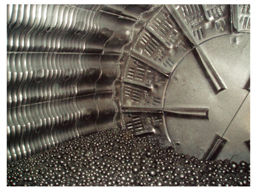RAP Innovation and Development Pty Ltd

Non Contact Acoustic Measurement of Grinding Mills
Traditionally, large grinding mills are understood in terms of the inputs and the outputs of the mills. The inputs are the ore hardness, ore feed size distributions, ore feed rate, water addition rates, steel ball loading, steel ball dimensions. The lifter design is also important as are the discharge characteristics of the mill. All of these variables and parameters influence the load inside the mill, the discharge grind size distribution as well as the throughput achievable with the mill circuit configuration. However, fundamental to the mill operation are the processes that are occurring inside the mill such as transport of material (rocks, steel balls, water), rheology, the lift of the charge of the mill, the breakage mechanisms and the wear of the mill liner. Often, load cells are used to measure the “load” inside a mill, bearing pressure is also used as an indicator. The mill power draw is also used to provide information on how well the mill is grinding.
Since the processes occurring inside the mill are usually not being directly measured, but are nevertheless fundamental to its successful operation, there is an imperative to measure these internal processes more directly. The hostile environment inside mills precludes a range of techniques that would otherwise be available. Non-contact acoustic measurement is a way around this dilemma, which has the additional benefit of measuring the processes in the frame of reference of the charge inside the mill. As a fast measurement technique, non-contact acoustics, provides real time dynamic measurement of in-mill processes. In its present form, RAP MachineNoiseAnalysis is a robust and powerful tool for the estimation of the in-mill dynamics and in-mill variables useful for control functions. Its role as a diagnostic tool has also been demonstrated.
The RAP machine noise analysis system is a non-contact acoustics system to determine the internal processes that occur inside equipment. It is particularly configured for grinding mills where several microphone configurations can be potentially used. These consist of a quadrant configuration, toe array and/or a shoulder array. Experimental data confirm that there is good discrimination between microphones in all configurations. Useful results can be obtained with all configurations of the microphones suggesting that eight microphones are necessary to provide comprehensive information about in-mill variables. Since acoustic measurements are made on a rapid time scale, the dynamics of mill operation can be determined. For example, a noteworthy new measurement has been the settling time for charge reorganisation inside SAG/AG mills after feed or speed changes. Typical times are of order 30 minutes.
The RAP machine noise analysis system consists of commercial hardware together with software to provide a virtual instrument (VI). The software provides a number of calculations using both time and frequency domain data obtained from the stationary microphones located around a mill. Diagnostic information for the hardware installation and trending of the process and acoustically derived data is also available. Communication with the site process control systems uses OPC or MODBUS, the latter is preferred.
Current results indicate that the acoustic measurements show significant sensitivity to in-mill conditions. Good results have been achieved for the determination of the load inside a mill. Independent longitudinal acoustic measurements show operating mills are far from perfect mixers. Algorithms have been developed for the determination of collision types, especially the mill shell steel hits. A rigidity of the charge at the toe of the charge (‘anvil’ effect) has also been observed using sound transmission through the charge. Different operations have different degrees of anvil behaviour.
The shoulder microphones allow the determination of two shoulder angles. The upper shoulder angle is due to large steel balls and the lower is due to the top of the rotating portion of the charge. A lack of a significant shoulder angle could indicate a degree of packing between the lifters. A toe angle can also be determined. The toe angle needs more work to enable its measurement under conditions of pooling. However the toe microphone information can be used to determine the proportion of unwanted liner impact by steel balls as well as the energetic of these processes.
